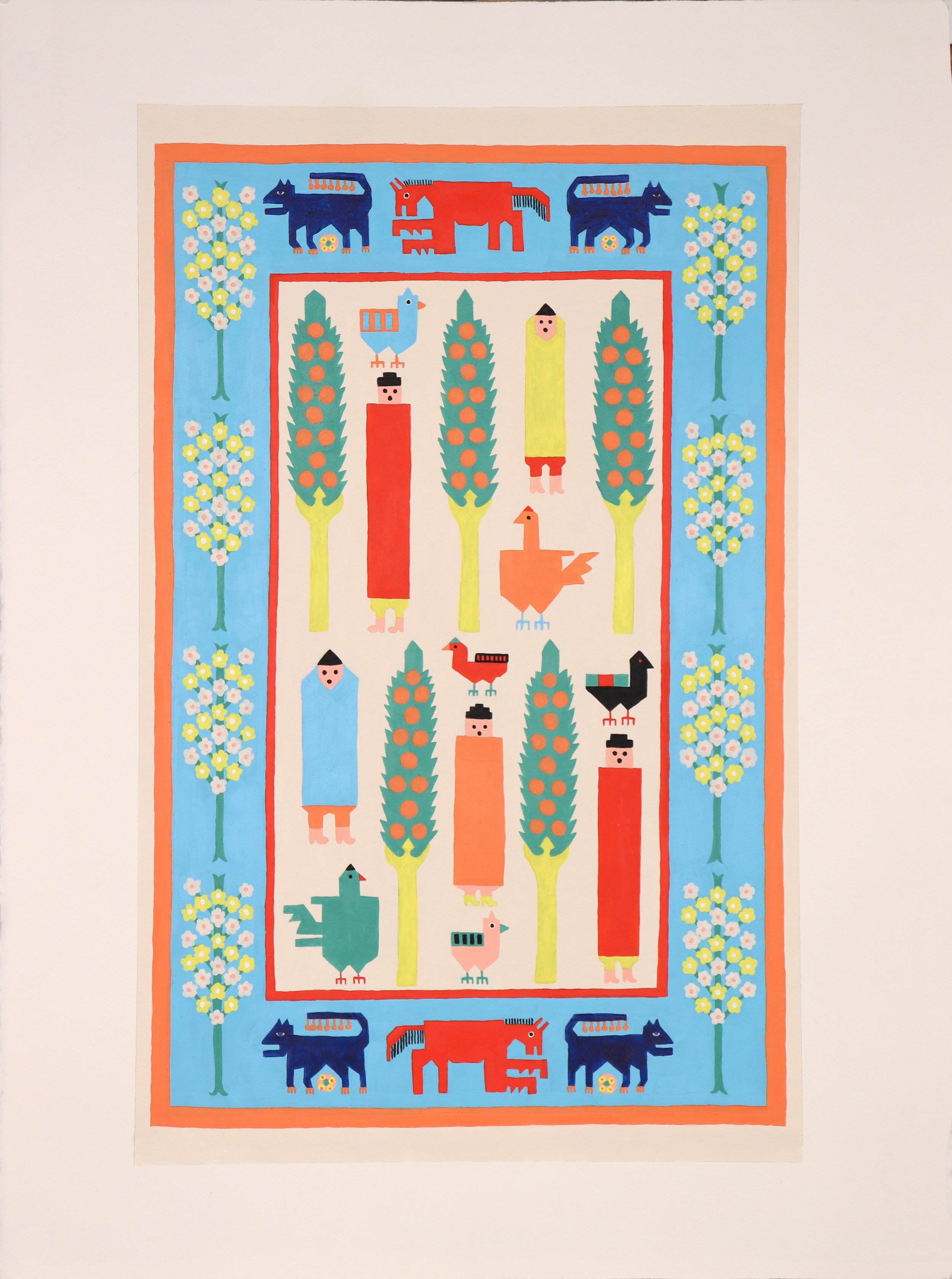The Contemporary Persian Rug
Hecho a Mano Gallery, Santa Fe, New Mexico
April 4 - April 28, 2025

Spring Goddess | Acrylic on paper | 25.25 x 22 in. | 2025

Ashurbanipal's Garden | Acrylic on Paper | 30 x 22.5 in. | 2025

Leopard Dance | Acrylic on paper | 30 x 22.5 in. | 2025

Assyrians at the Folk Art Museum | Acrylic on paper | 25.25 x 18.75 in. | 2025

Assyrians in the Bosque | Acrylic on paper | 30 x 22.5 in. | 2025

Springtime Royalty | Acrylic on Paper | 30 x 22.5 in. | 2025

Nasha Milta | Acrylic on paper | 25.25 x 18.75 in. | 2025

Palm Women | Acrylic on paper | 25.25 x 18.75 in. | 2025

The Pomegranate Farmer | Screenprint | 29.5 x 22 in. | 2025

Springtime Travel | Screenprint | 29.5 x 22 in. | 2025

Water Goddess | Screenprint | 29.5 x 22 in. | 2025

Leopard Goddess | Screenprint | 22 x 29.5 in. | 2025
Press Release
Born in Turlock, CA and now living and working in Albuquerque, NM, Esther Elia is an artist of mixed Assyrian and Irish descent. Her work — spanning sculptural furniture, clothing, and large-scale acrylic paintings — combats the idea that Assyrian art exists only in the ancient past. Brimming with defiant vitality, Elia’s work draws on history, family folklore and personal experience to explore what it means to be an Assyrian in diaspora. In this show, her paintings evoke the Persian rug as a lens through which to examine the pursuit of safety. Elia’s early work drew from oral histories, giving her “a shifting, fuzzy picture of my family’s experiences as survivors of a genocide.” She reflects that they tended to gloss over traumas, focusing instead on triumph: “We made it to the U.S., where we could finally breathe because we were safe.” “It’s very interesting to me, this idea of safety,” Elia says, reflecting that to her first generation relatives, it was black and white — in Iran their lives were in jeopardy; in the U.S. they were not. Still, many expat Iranians felt so unwelcome in the U.S. that they wouldn’t admit to their heritage, claiming instead to be Italian. As conflicts in Iran and surrounding areas were televised, sensationalizing war and destruction, “the effects of the bad press became garments worn by the people from those regions, masks many could not see behind,” Elia says. Her family had traveled to a so-called “land of safety,” only to discover it wasn’t so straightforward. Many gave up their language, married non-Assyrians, and converted from Orthodox Christianity to American Protestant denominations “because to identify fully as a white American created the greatest conditions for social safety,” Elia says. When her family fled Iran during the 1915 Armenian / Assyrian / Greek Genocide, one relative, Shaul, stopped in Chicago and befriended a Jewish man who had fled Iran years earlier and settled in Chicago as a Persian rug salesman. “He got [Shaul] started in the rug business out of the kindness of his heart and his determination to help his countrymen,” Elia says. “Needless to say, I grew up with Persian rugs in our home, and they became a huge aesthetic influence to me, my identity, and my work.” To Elia, the contemporary Persian rug is a history unfolding in real time. Persian rugs, kilims, suzanis and weavings from this area reflect the histories of the many nations that have claimed Persia. Weaving large, intricate rugs is “a family affair and takes many hands,” but tribal rug families are dwindling. Many weavings were used for nomadic dwellings — a lifestyle that has declined to around 1.25% in modern-day Iran. “There is a good chance we’re seeing the end of the hand-woven Persian rug,” Elia says. Cheaper, more convenient digitally-printed rugs are replacing the manual process as skills diminish, patterns become less intricate, and practices like child labor — favored because small fingers could create more intricate designs — are forbidden. Elia hopes to contribute to shaping the practice into something “protected, sustainable, and equally bewitching.” While Elia does not weave, her designs in this show engage with Persian rugs in a way she can access as the granddaughter of refugees growing up in diaspora. She created them while pregnant, spending her time looking through books on the antiquities of Ancient Assyria, Babylon and Persia, and making digital sketches on her iPad that she would later translate into paintings and prints. Relying heavily on digital drawing was new to her, but ended up creating fresh avenues and inspiration, connecting her to the “new history” she’s exploring — including the influence of the digital in cultural practices. “The pieces in this show have many elements that harken back to the ancient Assyrians, the art that was born out of the land of my people, while I grew in my belly a life that has roots in that land,” Elia says. April — the month of the show — “is the time of the New Year for Assyrians, the beginning of spring, so many of the paintings have elements of springtime, fertility, flora & fauna.” “I would be remiss if I didn’t bring up the heavy influence of Afghan War Rugs to this work,” Elia says, explaining that just as villagers in Afghanistan documented the Soviet Invasion through their kilims, she documents “the life around me, the ancestral ghosts that live within me, and the aesthetic elements that have followed me from Persia to New Mexico.” The Contemporary Persian Rug will open at Hecho a Mano on Friday, April 4, 5-7pm and will be on view until April 28.
